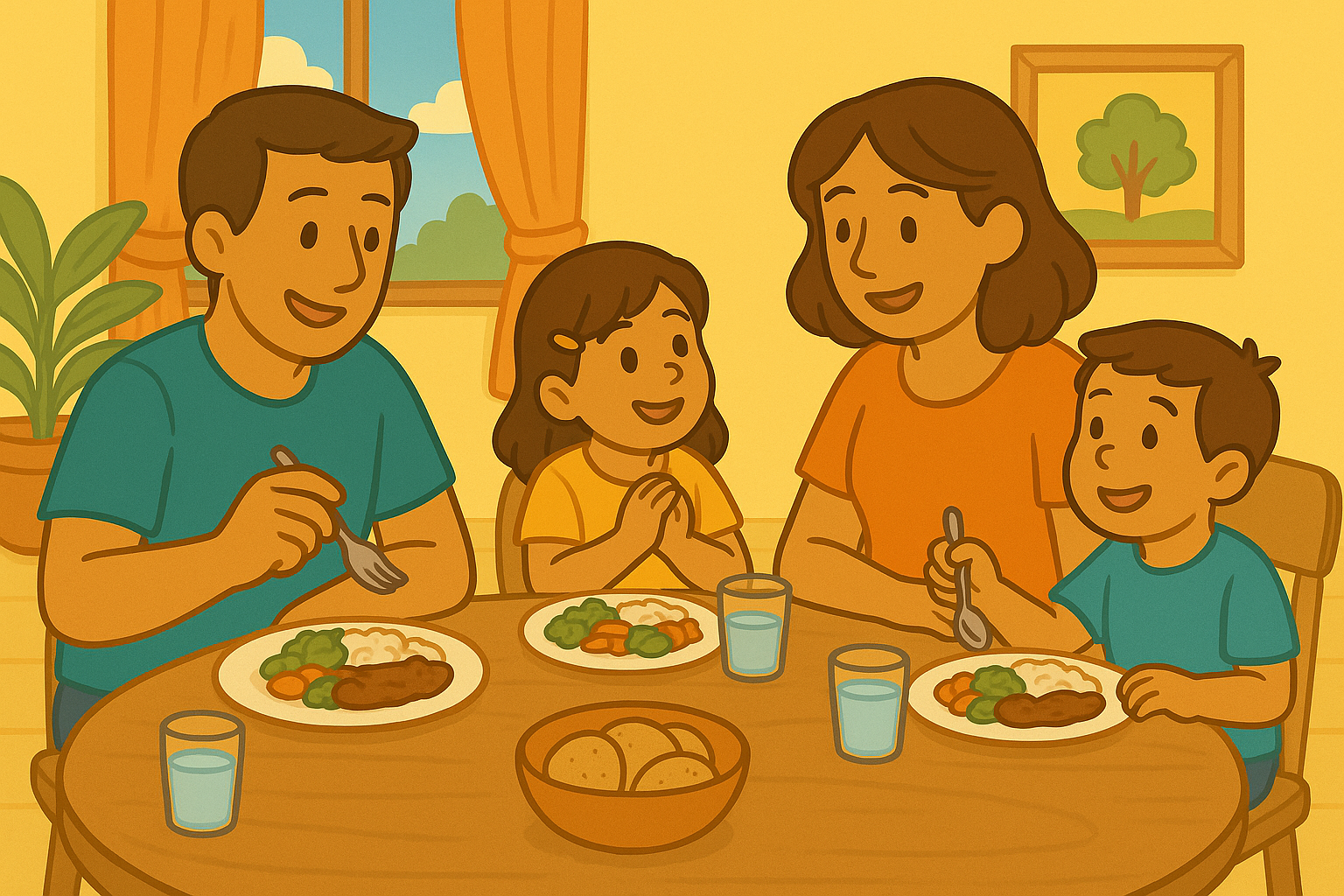Family Mealtime Rituals for Health and Connection
Family Mealtime Rituals for Health and Connection
Family meals are about far more than what’s on the plate — they’re about presence, rhythm, and connection. When families eat together, kids don’t just nourish their bodies — they nourish their sense of belonging, too.
Establishing simple, predictable mealtime rituals builds habits that anchor health, foster communication, and strengthen emotional bonds.
Why Mealtime Matters More Than We Think
In our busy lives, shared meals often get squeezed out by convenience foods or staggered schedules. But science — and simple observation — shows that sitting down together offers benefits far beyond nutrition.
Children who eat regularly with family tend to:
Eat more fruits and vegetables
Have lower rates of obesity and picky eating
Feel more emotionally secure and communicative
As explored in Encouraging Balanced Screen Habits at Mealtime, shared meals become a pause button — a time when family members reconnect without the noise of devices or deadlines.
The Ritual Behind the Routine
The word ritual might sound formal, but it simply means doing something with intention. Whether it’s lighting a candle, saying a short “thank you,” or letting each person share one good thing from their day — these moments transform ordinary meals into something memorable.
Rituals give children predictability. They know what to expect, which helps them feel grounded and calm. When kids feel emotionally safe, they’re more open to trying new foods and engaging in conversation.
Setting the Stage for Togetherness
A mealtime environment doesn’t need to be fancy — it just needs to feel inviting.
Try these small but powerful changes:
Dim harsh lights and use natural or soft lighting
Play calm background music instead of TV noise
Let kids help set the table — even if it’s imperfect
Create a “no devices” rule everyone follows
Consistency in setting the scene builds anticipation and signals: this is family time. The visual and emotional cues help transition from daily chaos to calm connection.
Involving Kids in Preparation
When children help prepare meals, they’re more likely to eat them. Participation builds both confidence and curiosity.
Start with age-appropriate tasks:
Toddlers: wash veggies, stir batter, sprinkle toppings
Preschoolers: measure ingredients, tear lettuce
Older kids: chop soft foods, serve portions, pack leftovers
As shared in Healthy Baking Ideas for Kids, including children in the process teaches them that food isn’t just something that appears — it’s something made with care and shared with love.
Building Mealtime Mindfulness
Mindful eating helps children slow down, notice their hunger, and appreciate their food. You don’t need formal meditation — just attention.
Ways to make meals more mindful:
Take a deep breath before eating
Talk about flavors, colors, and textures
Encourage small bites and chewing slowly
Let silence happen — quiet moments teach calmness
Parents can model gratitude and awareness. When meals aren’t rushed, children learn that nourishment is both physical and emotional.
The Power of Conversation
Dinner tables are emotional classrooms. When families talk, kids learn empathy, listening, and how to express themselves.
Try a few simple conversation starters:
“What made you smile today?”
“What’s one thing you learned?”
“How did you help someone today?”
Keep topics light for younger children and affirm participation — even from shy ones. Avoid using meals for lectures or correction; connection should come first. The goal is to create emotional safety, not performance pressure.
Routines That Anchor Nutrition
Routine doesn’t mean rigidity. It simply means having predictable mealtime rhythms that support good habits.
For example:
Breakfast within an hour of waking
Lunch that balances energy and focus
Dinner that’s screen-free and shared
As emphasized in How to Build a Balanced Plate for Every Meal, consistency teaches kids to regulate appetite, understand fullness, and avoid emotional eating later in life. Mealtime rhythms tell the body and brain, “it’s time to refuel and connect.”
Turning Mealtime Into a Learning Moment
Food is a natural teacher — it can spark curiosity about culture, science, and gratitude.
You can:
Explore where foods come from — farms, gardens, or family recipes
Try “color challenges” (eating all the colors of the rainbow)
Let kids invent simple menu themes like “Taco Tuesday” or “Green Plate Night”
These learning moments tie nutrition to creativity, turning meals into both bonding and discovery time.
Handling Resistance Without Power Struggles
Almost every parent has faced the “I don’t want that” moment. Instead of making food a battleground, focus on calm consistency.
Gentle approaches:
Offer at least one familiar food per meal
Serve small portions — kids can always ask for more
Avoid bribing with dessert
Model trying new foods together
As highlighted in How to Handle Food Refusal Without Stress, the goal isn’t immediate compliance — it’s long-term comfort with variety. Respecting a child’s autonomy helps preserve trust and curiosity about food.
Making Mealtime Connection Sustainable
The most successful rituals are the simplest ones. You don’t need elaborate setups — just small consistencies that fit your family’s rhythm.
Try designating one meal a day (or a few per week) as your family’s “together time.” Even breakfast counts if evenings are hectic. You can also share weekend brunches or outdoor picnics to make variety part of your connection routine.
Keep expectations low, warmth high, and flexibility alive — that’s what keeps rituals thriving long-term.
When Meals Become Memories
What children will remember years from now isn’t the food — it’s the feeling. The laughter at the table, the comfort of family rhythm, the stories told between bites — those moments weave into the foundation of emotional security.
Family mealtime rituals teach children that nourishment is love, structure, and belonging rolled into one. When the table becomes a safe space, it becomes the heart of the home — where growth happens in every sense of the word.
This content is for educational purposes and is not a substitute for professional medical or psychological advice.
Popular Parenting Articles


